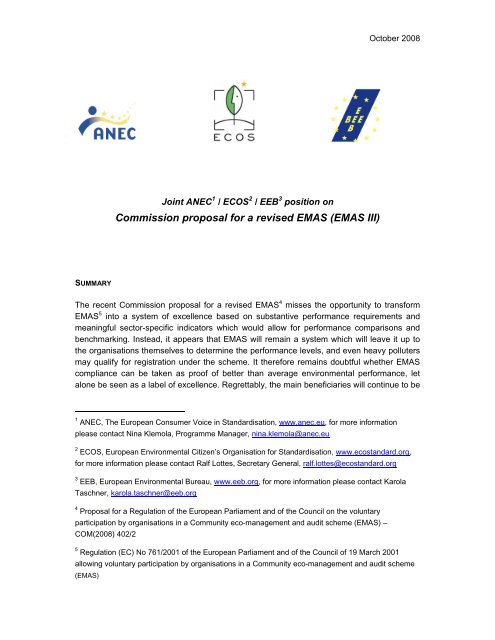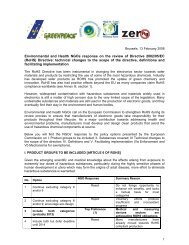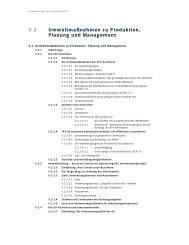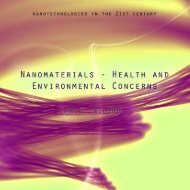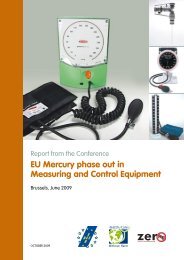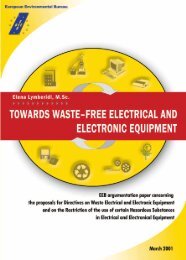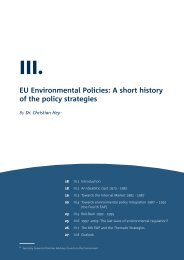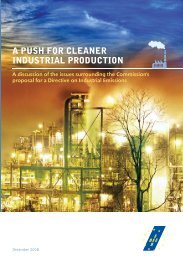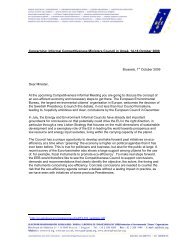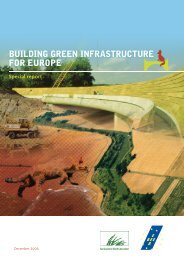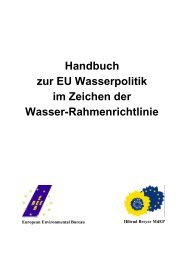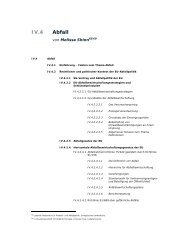EMAS III - European Environmental Citizens Organisation for ...
EMAS III - European Environmental Citizens Organisation for ...
EMAS III - European Environmental Citizens Organisation for ...
Create successful ePaper yourself
Turn your PDF publications into a flip-book with our unique Google optimized e-Paper software.
October 2008<br />
Joint ANEC 1 / ECOS 2 / EEB 3 position on<br />
Commission proposal <strong>for</strong> a revised <strong>EMAS</strong> (<strong>EMAS</strong> <strong>III</strong>)<br />
SUMMARY<br />
The recent Commission proposal <strong>for</strong> a revised <strong>EMAS</strong> 4 misses the opportunity to trans<strong>for</strong>m<br />
<strong>EMAS</strong> 5 into a system of excellence based on substantive per<strong>for</strong>mance requirements and<br />
meaningful sector-specific indicators which would allow <strong>for</strong> per<strong>for</strong>mance comparisons and<br />
benchmarking. Instead, it appears that <strong>EMAS</strong> will remain a system which will leave it up to<br />
the organisations themselves to determine the per<strong>for</strong>mance levels, and even heavy polluters<br />
may qualify <strong>for</strong> registration under the scheme. It there<strong>for</strong>e remains doubtful whether <strong>EMAS</strong><br />
compliance can be taken as proof of better than average environmental per<strong>for</strong>mance, let<br />
alone be seen as a label of excellence. Regrettably, the main beneficiaries will continue to be<br />
1 ANEC, The <strong>European</strong> Consumer Voice in Standardisation, www.anec.eu, <strong>for</strong> more in<strong>for</strong>mation<br />
please contact Nina Klemola, Programme Manager, nina.klemola@anec.eu<br />
2 ECOS, <strong>European</strong> <strong>Environmental</strong> Citizen’s <strong>Organisation</strong> <strong>for</strong> Standardisation, www.ecostandard.org,<br />
<strong>for</strong> more in<strong>for</strong>mation please contact Ralf Lottes, Secretary General, ralf.lottes@ecostandard.org<br />
3 EEB, <strong>European</strong> <strong>Environmental</strong> Bureau, www.eeb.org, <strong>for</strong> more in<strong>for</strong>mation please contact Karola<br />
Taschner, karola.taschner@eeb.org<br />
4 Proposal <strong>for</strong> a Regulation of the <strong>European</strong> Parliament and of the Council on the voluntary<br />
participation by organisations in a Community eco-management and audit scheme (<strong>EMAS</strong>) –<br />
COM(2008) 402/2<br />
5 Regulation (EC) No 761/2001 of the <strong>European</strong> Parliament and of the Council of 19 March 2001<br />
allowing voluntary participation by organisations in a Community eco-management and audit scheme<br />
(<strong>EMAS</strong>)
consultants and verifiers involved with <strong>EMAS</strong>, rather than the environment. Despite this,<br />
ANEC, ECOS, and EEB welcome some of the proposed changes, such as the announced<br />
development of sector-specific best practice documents including indicators, as positive<br />
steps in the right direction.<br />
However, ANEC, ECOS, and EEB underline the need <strong>for</strong> significant changes to ensure<br />
credibility of the system and to differentiate <strong>EMAS</strong> compliant organisations from those which<br />
only con<strong>for</strong>m to ISO 14001 6 . Such measures include the following:<br />
• At the very minimum, industrial <strong>EMAS</strong> organisations must comply with BAT 7 , i.e. must<br />
provide evidence that they comply, or are even better than the state-of-the-art as<br />
described in the BREF documents 8 , where these exist. Where such documents<br />
contain per<strong>for</strong>mance ranges, the <strong>EMAS</strong> registered organisation should have a<br />
per<strong>for</strong>mance corresponding to the top of the range.<br />
• The envisaged sectoral reference documents must include best practice<br />
environmental per<strong>for</strong>mance levels, and must be binding rather than voluntary.<br />
Further, the Commission should have a clear obligation to come up with working<br />
plans based on agreed priorities and targets similar to the existing Energy-Using<br />
Products Directive 9 . These documents should be based on a high level of ambition<br />
awarding only organisations with a better than average environmental per<strong>for</strong>mance<br />
which is significantly better than the legal minimum, and should provide benchmarks<br />
covering all significant direct and indirect environmental aspects.<br />
• These sectoral reference documents should also identify a limited number of relevant<br />
and comparable (sub) sector-specific indicators. These indicators ought to cover not<br />
only direct but also indirect impacts (in particular from products) and should be<br />
compulsory, once available. Sufficient resources should be made available <strong>for</strong> this.<br />
• The use of the <strong>EMAS</strong> logo on products or in connection with product<br />
in<strong>for</strong>mation/advertising must be strictly prohibited. Such use would open the door to<br />
misuse and confusion with eco-labels.<br />
• Any incentives <strong>for</strong> organisations or promotion activities should not be accepted until<br />
<strong>EMAS</strong> has been trans<strong>for</strong>med into a system awarding only top per<strong>for</strong>mers.<br />
6 ISO 14001:2004 <strong>Environmental</strong> management systems - Requirements with guidance <strong>for</strong> use<br />
7 BAT – Best Available Technology<br />
8 Best Available Technique Reference Documents<br />
9 Directive 2005/32/EC establishing a framework <strong>for</strong> the setting of eco-design requirements <strong>for</strong> energyusing<br />
products<br />
2
INTRODUCTION<br />
In July 2008 the Commission presented a proposal <strong>for</strong> the second revision of the <strong>EMAS</strong><br />
regulation. One of the main aims of revising <strong>EMAS</strong> is to increase participation, and to make<br />
the scheme more attractive to organisations by promotion and reduction of administrative<br />
burdens, in particular <strong>for</strong> SMEs, and by extending it beyond Europe. The Commission’s<br />
primary goal is to increase the number of registered sites from circa 6,000 to 35,000 within<br />
10 years after the entry into <strong>for</strong>ce of this Regulation - thus equaling the number of<br />
organisations or sites currently certified under the ISO 14001:2004. On the other hand it is<br />
the objective of the proposal to strengthen the political profile of the scheme and have it<br />
recognised as a benchmark <strong>for</strong> environmental management systems (EMS). This is intended<br />
to be achieved by the introduction of general per<strong>for</strong>mance indicators and the announcement<br />
of the development of sector-specific best practice documents, including specific indicators,<br />
and rein<strong>for</strong>cing measures on compliance with environmental legislation.<br />
It is, however, doubtful whether these goals will be reached. A strong move from ISO 14001<br />
to <strong>EMAS</strong> is unlikely to happen unless <strong>EMAS</strong> provides a significant added value compared to<br />
its ISO counterpart. The key question is there<strong>for</strong>e whether <strong>EMAS</strong> can be considered as a<br />
label <strong>for</strong> best environmental per<strong>for</strong>mance. The so-called EVER study 10 , carried out on behalf<br />
of DG Environment of the <strong>European</strong> Commission, included the statement that most<br />
quantitative studies have not been able to confirm a better environmental per<strong>for</strong>mance of<br />
<strong>EMAS</strong>-registered organisations as compared to other organisations, and that <strong>EMAS</strong> is not<br />
generally seen as a benchmark of environmental per<strong>for</strong>mance.<br />
Despite this, we regret to note that substantive environmental per<strong>for</strong>mance requirements did<br />
not find their way into the revised scheme. Under the proposal, the organisations would<br />
remain entirely free to chose ambition levels themselves. The only tangible requirement is<br />
(and was) to comply with legislation – hardly a demanding pre-requisite <strong>for</strong> an environmental<br />
certificate. The only other per<strong>for</strong>mance-related requirement is the commitment to “continual<br />
improvement” – a rather vague notion which can be interpreted in many ways. It is, <strong>for</strong><br />
instance, entirely unclear how many environmental impacts have to be improved upon, and<br />
to which extent. After all, even a heavy polluter can claim to comply with this principle based<br />
on marginal advancements in some areas.<br />
Moreover, there are only few changes aimed at enhancing the (poor) credibility of the<br />
system, including the introduction of generic core per<strong>for</strong>mance indicators - the benefit of<br />
which can be called into question, as outlined below. Although, the announcement of sectorspecific<br />
guidance documents (including specific indicators) is a very positive step which<br />
deserves to be applauded, it remains to be seen how ambitious the Commission will be in<br />
pursuing the preparation of such documents considering the lack of concrete targets or an<br />
obligation to provide working plans.<br />
All other proposed changes are related to an extension of the system through promotion and<br />
provision of incentives. As long as the scheme does not ensure a high level of environmental<br />
per<strong>for</strong>mance, and does not provide instruments allowing <strong>for</strong> an assessment of the<br />
10 “Evaluation of <strong>EMAS</strong> and Eco-label <strong>for</strong> their Revision”, 26 December 2005<br />
3
environmental achievements in terms of clear-cut comparable indicators and benchmarks,<br />
ANEC, ECOS and EEB do not consider the proposed measures to be appropriate.<br />
CRITIQUE BY THE EUROPEAN CONSUMER AND ENVIRONMENTAL ORGANISATIONS<br />
The umbrella federations of the <strong>European</strong> environmental and consumer organisations 11 have<br />
<strong>for</strong> many years questioned the value and usefulness of the <strong>EMAS</strong> systems. In particular, the<br />
organisations have called <strong>for</strong> a substantive re<strong>for</strong>m aimed at trans<strong>for</strong>ming <strong>EMAS</strong> into an<br />
environmental label <strong>for</strong> organisations – into a true “system of excellence” 12 . The central<br />
points of criticism on environmental management systems, including <strong>EMAS</strong> and ISO 14001,<br />
were:<br />
• The approach tends to shift decision-making on environmental per<strong>for</strong>mance issues<br />
from democratic institutions, involving public interest advocates, to companies.<br />
• The business interest is limited to environmental investments which pay off, whilst<br />
many protection measures are not profitable.<br />
• EMS systems do not require a minimum environmental per<strong>for</strong>mance and even legal<br />
compliance cannot be taken <strong>for</strong> granted.<br />
• EMS certifications do not allow <strong>for</strong> a differentiation between good and bad<br />
per<strong>for</strong>mers.<br />
• Tax reductions or reduced governmental controls linked to EMS compliance are<br />
questionable because of the fact that such compliance does not mean better<br />
environmental per<strong>for</strong>mance.<br />
• There is little convincing evidence on the table which would suggest that the<br />
implementation of an EMS standard has indeed boosted environmental per<strong>for</strong>mance.<br />
• Reporting requirements are either missing (ISO 14000), or inadequate (<strong>EMAS</strong>),<br />
lacking clearly defined key indicators of environmental per<strong>for</strong>mance and scales of<br />
comparison.<br />
The position paper contains a detailed discussion and justification of these points as well as<br />
suggestions <strong>for</strong> alternative approaches.<br />
11 ANEC, BEUC (the <strong>European</strong> Consumers <strong>Organisation</strong>), ECOS (<strong>European</strong> <strong>Environmental</strong> Citizen’s<br />
<strong>Organisation</strong> <strong>for</strong> Standardisation), and EEB (<strong>European</strong> <strong>Environmental</strong> Bureau)<br />
12 See joint ANEC, BEUC, ECOS, EEB paper “Making <strong>EMAS</strong> a system of excellence – Going beyond<br />
EMS” - http://www.anec.org/attachments/ANEC-ENV-2006-G-047.pdf<br />
4
THE ALTERNATIVE APPROACH – STAYING BELOW BAT LEVELS<br />
With sufficient political will <strong>EMAS</strong> could be trans<strong>for</strong>med into a a demanding eco-label <strong>for</strong><br />
organisations - into a true system of excellence – within a few years, without unjustifiably<br />
high expenses. Sector-specific rules could easily be established based on BAT levels as<br />
defined in <strong>European</strong> BREF documents, eco-label criteria, ”black lists” of chemicals intended<br />
to be phased out, and other benchmarks <strong>for</strong> e.g. buildings’ energy demands. One possible<br />
option could be to require <strong>EMAS</strong> registered organisations to stay below BAT levels, or to<br />
have a per<strong>for</strong>mance corresponding to the lower third where ranges of per<strong>for</strong>mance are<br />
indicated in BREF documents (which is often the case with emissions). One could even<br />
envisage a process where top levels are identified in the BREF documents themselves.<br />
BREF documents are available <strong>for</strong> many industrial processes. For processes or aspects not<br />
covered (e.g. products) or <strong>for</strong> non-industrial areas the state-of-the art will have to be defined<br />
separately. ANEC, ECOS, and EEB strongly support the concept of sectoral reference<br />
documents and the envisaged approval process making use of a comitology procedure, and<br />
consider this to be an excellent opportunity to initiate changes in the right direction. However,<br />
the use of sectoral reference documents should be binding rather than voluntary (i.e. the<br />
identified best practice per<strong>for</strong>mance levels should be obligatory), and the Commission should<br />
have a clear obligation to come up with working plans based on agreed priorities and targets,<br />
similar to the process under the existing Energy-Using Products Directive. Sufficient<br />
resources would need to be made available <strong>for</strong> this.<br />
Moreover, multinational organisations should be obliged to apply the same (high)<br />
environmental criteria in all the countries in which they operate, including those outside the<br />
EU.<br />
THE ALTERNATIVE APPROACH – SPECIFIC COMPARABLE KEY PERFORMANCE INDICATORS (KPIS)<br />
The Commission proposal introduces the obligation to make use of general “core indicators”<br />
both in the environmental statement and the environmental per<strong>for</strong>mance report. These<br />
include energy efficiency, material efficiency, water, waste, biodiversity, and emissions (only<br />
direct aspects). In addition to the total amounts (e.g. of water per year), normalised figures<br />
must be indicated by relating the environmental burdens to the total annual gross value<br />
added (industry in the production sector), the total annual turnover or number of employees<br />
(small organisations), or number of employees (organisations in the non-productive sectors).<br />
At a later stage these indicators are intended to be complemented by sector-specific<br />
indicators incorporated into sector-specific reference documents, to be approved through the<br />
comitology procedure.<br />
However, generic indicators such as total energy consumption are normally not meaningful<br />
as they do not allow <strong>for</strong> reasonable comparisons between organisations. Even if such data<br />
are related to the physical or monetary output, including the value added or number of<br />
employees, they say very little, and could be equated with the results of comparing apples<br />
and pears. A prerequisite <strong>for</strong> serious assessments of per<strong>for</strong>mance and benchmarking is to<br />
compare comparable activities or processes. Different companies can have quite different<br />
portfolios of products and the vertical integration of manufacture might be completely<br />
5
different. For instance, some companies produce textiles whilst others only trade in them, not<br />
to mention the number of mixed approaches in between. The level of outsourcing of stages<br />
of production can differ significantly between enterprises.<br />
By relating the environmental impacts to turnover or value added the environmental balance<br />
may even be distorted. A producer of luxury cars with a high (added) value will have a<br />
comparatively good ecological record compared to a producer of cheaper cars, wrongly<br />
suggesting a better environmental per<strong>for</strong>mance of the <strong>for</strong>mer (a higher denominator means a<br />
lower value).<br />
Moreover, the direct indicators may be irrelevant compared to impacts in other life cycle<br />
stages. Staying with the car example – the burdens associated with the assembly of cars are<br />
just a minor fraction of the overall impacts. Much more relevant are the production of raw<br />
materials (e.g. steel) and, in particular, the use of the cars (petrol consumption). So <strong>for</strong> the<br />
cars industry the relevant energy indicator is not the annual “total direct energy use” divided<br />
by the gross value added, but the average fleet consumption.<br />
Also, in our view the Commission proposal lacks clarity regarding the details of the energy<br />
and material flows to be included. For instance, it is not clear which materials should be<br />
recorded at which level of precision using which methods? Without clear-cut rules <strong>for</strong> this the<br />
indicator results are unlikely to be more than arbitrary figures.<br />
The numerous problems associated with the development of meaningful comparable<br />
indicators were investigated in a study published by the Consumer Council at the Austrian<br />
Standards Institute 13 in 2008. A major conclusion was that such indicators can only be<br />
derived at a (sub) sector level focusing on processes or products (e.g. energy consumption<br />
<strong>for</strong> the production of 1 t of cement), defining precisely the method of calculation and the<br />
system boundaries. A general procedure <strong>for</strong> deriving such indicators was suggested.<br />
Hence, ANEC, ECOS and EEB consider the proposed general indicators to be of little use.<br />
Instead, we believe the focus should be on the development of a limited number of relevant<br />
and comparable (sub) sector-specific indicators. These indicators should cover also indirect<br />
impacts (in particular products) and should be compulsory once they are available. Also, the<br />
revised <strong>EMAS</strong> regulation should contain an obligation <strong>for</strong> the Commission to provide a<br />
working plan.<br />
Finally, the Commission should be obliged to elaborate rating and ranking systems using the<br />
indicators referred to above.<br />
LEGAL COMPLIANCE<br />
ANEC, ECOS, and EEB welcome the provisions to rein<strong>for</strong>ce legal compliance verification<br />
through stronger involvement of en<strong>for</strong>cement authorities. The proposed system to be<br />
established by the Member States to assist in identifying and verifying legal obligations is<br />
13 Consumer Council at the Austrian Standards Institute “Comparable environmental indicators <strong>for</strong><br />
companies”, carried out by Force Technology, Denmark, 2008<br />
http://www.verbraucherrat.at/download/envindicators.pdf<br />
6
useful even <strong>for</strong> organisations not interested in an <strong>EMAS</strong> registration. Further, we appreciate<br />
that organisations “shall provide material or documentary evidence showing that the<br />
organisation complies with all applicable legal requirements relating to the environment that<br />
have been identified” 14 be<strong>for</strong>e registration.<br />
However, we consider it insufficient that the statement on compliance from the competent<br />
en<strong>for</strong>cement authority is merely optional, rather than compulsory. In addition, in our view this<br />
confirmation should be renewed every three years – in line with the regular maintenance<br />
cycle.<br />
Finally, <strong>EMAS</strong> registered organisations should be obliged to publish any environmental data<br />
regarding legal compliance (e.g. measured values where legal limits exist), as well as all<br />
cases of non-compliance or possible penalties.<br />
INITIAL REVIEW<br />
An audit (e.g. carried out under ISO 14001) can exempt a company from having to conduct a<br />
”full” initial environmental review. However, such a review, including the compulsory<br />
procedures to follow, may not be envisaged in the recognised certified environmental<br />
management system (as in the case of ISO 14001). It is also unclear what “full” means –<br />
which elements could be omitted and who would take the relevant decisions. Hence, this<br />
unclear exemption does not seem to be justified.<br />
USE OF THE <strong>EMAS</strong> LOGO<br />
ANEC, ECOS and EEB strongly disagree with the suggested new provisions regarding the<br />
use of the <strong>EMAS</strong> logo on products as this will open the door to a number of possible means<br />
of misuse. In the current version of <strong>EMAS</strong> the use of the logo on products is strictly<br />
<strong>for</strong>bidden, and its use in the context of product advertising subject to restrictions by<br />
Commission Decision 2001/681/EC. According to this Decision the basic principle is to use<br />
the logo only in connection with validated in<strong>for</strong>mation regarding environmental product<br />
features: “In no case must the logo be used alone in adverts <strong>for</strong> products, activities and<br />
services (like an eco-label). A clearly visible connection to the validated in<strong>for</strong>mation is<br />
necessary” 15 . Un<strong>for</strong>tunately even these restrictions are not enough to exclude<br />
misunderstandings or misuses as the broad public are likely to interpret any logo as an ecolabel.<br />
Considering the above, the new text should be considered as a big step backwards<br />
compared to the existing unsatisfactory version. The new wording states that “the logo shall<br />
not be used in conjunction with comparative claims concerning other activities and services<br />
14 Article 4(5) of new <strong>EMAS</strong> proposal (COM(2008) 402/2<br />
15 2001/681/EC, Annex <strong>III</strong>, 5(1)<br />
7
or in a way that may create confusion with environmental product labels” 16 . Regrettably this<br />
<strong>for</strong>mulation does not offer an answer to the question of who will decide what ‘may create<br />
confusion’? Should the decision be left to the industry alone, it will be easy to <strong>for</strong>esee what<br />
the result will be and the provisions will likely be used to falsely claim environmental<br />
excellence of products where there is none (<strong>EMAS</strong> does not even ensure excellence with<br />
respect to direct environmental effects of organisations).<br />
Following from this, ANEC, ECOS and EEB stress that the use of the <strong>EMAS</strong> logo on<br />
products or in connection with product in<strong>for</strong>mation/advertising must be strictly prohibited.<br />
PROMOTION, INCENTIVES<br />
The Commission proposal suggests several measures to make <strong>EMAS</strong> registration more<br />
attractive <strong>for</strong> organisations. These include promotion activities by Member States, particular<br />
incentives <strong>for</strong> small organisations, pushing <strong>EMAS</strong> by embedding the scheme in other<br />
legislation, providing <strong>for</strong> financial subsidies (e.g. reduced taxes), and exempting<br />
organisations from, or reducing, the legal obligations. Article 35 of the proposal goes even so<br />
far as to suggest that the advertising should involve “industrial associations, consumer<br />
organisations, environmental organisations, trade unions and local institutions”.<br />
ANEC, ECOS and EEB must underline that any advertising or incentives <strong>for</strong> a system which<br />
is doubtful in terms of its environmental benefit, and which can be regarded as a <strong>for</strong>m of<br />
marketing rather than a sound environmental policy instrument - at the expense of the<br />
taxpayer - is not acceptable. Hence any incentive must be linked to per<strong>for</strong>mance<br />
achievements rather than be based on mere registration to the scheme. Similarly, regulatory<br />
reliefs should only be acceptable if the system has been made much more demanding than<br />
is currently the case.<br />
A new element in the <strong>EMAS</strong> <strong>III</strong> proposal is the attempt to allow organisations outside the EU<br />
to register in a Member State of their choice. However, it will be very difficult to assess legal<br />
compliance and the environmental achievement of an organisation outside the EU. Hence,<br />
we do not believe it to be possible to have a credible <strong>EMAS</strong> if the scheme is extended to<br />
organisations outside the EU.<br />
Finally, ANEC, ECOS and EEB question a stepwise approach to <strong>EMAS</strong> as the scheme does<br />
not stipulate stringent requirements, so establishing a ‘weaker brother’ of a weak system<br />
seems futile. Moreover, we must express our objections to the provisions which would allow<br />
recognition of other existing management systems – thus potentially undermining the<br />
crediblility of <strong>EMAS</strong> even further. In our view allowing such practice would be diametrically<br />
opposed to the idea of <strong>European</strong> harmonisation.<br />
16 Article 10(4) of new <strong>EMAS</strong> proposal (COM(2008) 402/2<br />
8
VERIFICATION<br />
In order to ensure that the strong competition between agencies providing verification<br />
services will not become a race to the bottom (where the interest to please the client is more<br />
important than a critical assessment), it should be stipulated that the contract is not made<br />
between the organisation and the verifier but between the competent body and the verifier.<br />
Furthermore, ANEC, ECOS, and EEB do not consider it sufficient to call <strong>for</strong> independence of<br />
the environmental verifier. Regrettably the term “independent” has nowadays lost its original<br />
meaning - being a third party - not least because of its redefinition in the standards bodies<br />
which does not rule out the possibility of it being a first party (i.e. being part of the<br />
organisation). It should in our view there<strong>for</strong>e be clearly stated that the verifier shall be an<br />
external third party.<br />
Finally, we find the provisions concerning the verification and validation of small<br />
organisations (SMEs) to be too vague, leaving much room <strong>for</strong> interpretation. There can in our<br />
view be no justification <strong>for</strong> applying double standards <strong>for</strong> verification and validation<br />
requirements depending on the size of the organisation.<br />
FINANCING OF <strong>EMAS</strong> IMPLEMENTATION<br />
It is questionable whether the ambitious tasks of the Commission can be conducted and<br />
realised in practice with the resources earmarked. In particular, the total number of human<br />
resources per year – a mere 10 from 2010 - and the total amount available <strong>for</strong> external<br />
studies – from 0,25 to 0,75 million Euro per year - seems insufficient, especially when<br />
starting to develop the announced sectoral reference documents, including best<br />
environmental management practice and environmental per<strong>for</strong>mance indicators <strong>for</strong> specific<br />
sectors. It is of utmost importance to ensure the necessary financial support <strong>for</strong> the<br />
Commission services if <strong>EMAS</strong> is to be lifted from a mere green alibi of low credibility to a real<br />
full-blown instrument of high ambition.<br />
CONCLUSIONS<br />
ANEC, ECOS, and EEB have long called <strong>for</strong> a substantial revision of <strong>EMAS</strong> in order to<br />
trans<strong>for</strong>m it into a true system of excellence. In doing so the organisations have, inter alia,<br />
highlighted the need <strong>for</strong> per<strong>for</strong>mance requirements and <strong>for</strong> a mandatory set of comparable<br />
per<strong>for</strong>mance indicators. Despite envisaging sector-specific best practice documents and<br />
rein<strong>for</strong>ced legal compliance verification, which the organisations welcome as steps in the<br />
right direction, the proposal put <strong>for</strong>ward by the <strong>European</strong> Commission does not deliver the<br />
change so urgently needed. Be<strong>for</strong>e incentive schemes are set up or promotional activities<br />
are allowed, the current proposal should be modified to ensure that the new <strong>EMAS</strong> can be<br />
equated with better environmental per<strong>for</strong>mance of organisations.<br />
END.<br />
9


